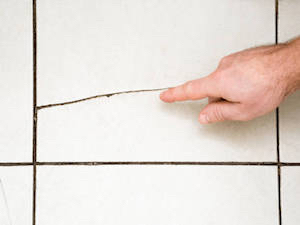Well, it looks like Bill had another problem. This time he identified cracking wall grout in the custom built walk-in shower next to the master bedroom.
It appears that the grout is cracking. Bill tried, as in his previous floor tiles, to fix the crack by dabbing on some clear silicone. This only made the problem worse, as the silicone supported additional mould growth, making the wall look horrible.
Why?
Once again the big “W” confronts us. Why did this happen? In order to understand it we have to understand the underlying wall geography.
In North America walls are commonly built with wood studs. Wood studs are dimensional lumber that run from the floor to the ceiling of a room or house. They can be either a 2 x 4 inch or 2 x 6 inch construction.
These are installed so that they are equally spaced. The spacing between centres is usually 16 inches. However we may also find them, in non load bearing walls at 24 inches between centres.
When buildings go up the walls are usually faced with 4 ft. x 8 ft. material, such as gypsum wallboard. Spacing the studs at 16 inch or 24 inch centres ensures that these materials can be installed with the joints landing on a stud. Allowing the joints to meet at the stud centre supports the wall materials from moving or deflecting.
There is a way to prevent the movement, which is by putting a 1 by 3 inch or a 1 by 4 inch strapping behind the joint. Installers don’t always do this.
Ignoring Common Sense
Sometimes, for whatever reasons wall board installers get sloppy. It could be the pressure, could be the profitability, or could be just laziness. Sometimes they put a joint in between studs. Without support from the back of the joint, the wall is prone to movement and deflection.
So the tile installer comes along, and installs the tiles on the wall. With luck the width of the tiles will be such that a tile will overlap the wallboard seam. The odd time, based on the selected tiles and the size of the wall being tiled, the joint between the tiles ends up right above the joint in the wallboard. Bingo! You have a problem just waiting to present itself.
When Will I Know?
 The unfortunate thing about construction is that problems don’t often immediately present themselves. Sometimes we only notice them after our new home warranty has expired.
The unfortunate thing about construction is that problems don’t often immediately present themselves. Sometimes we only notice them after our new home warranty has expired.
To give you an example, a homeowner bought a brand new home in Brampton, Ontario. It took over 8 years for a plumbing oversight to present itself as a mould problem.
Too late for coverage, yet the source of the problem was there right from the start. This is why it is always a good idea to keep a really keen eye on every little detail of the home and any changes or issues that don’t seem normal.
What Can I do About the Problem?
There is not much you can do in the way of a permanent fix when the wallboard joints are unsupported. Unless of course you are willing to demolish the shower and rebuild from scratch. There are however ways of extending the useful life of the unit until you are in a position to pay thousands of dollars to rebuild your shower.
One of the ways is to replace the cracking grout with a siliconized grout. Siliconized grout is flexible and can withstand the natural expansion and contraction of the ceramic tiles that occurs as the bathroom is in use. Movement of the tiles does not stop, however the slight movement will not crack the joint material, unlike regular grout. Siliconized, colour matched grouts are manufactures by such companies as Mapei and Polyblend in a number of colours that match their grout offerings in both unhanded (wall) and sanded (floor) types. These products are available in big box stores and ceramic tile suppliers.
Since the grout in your bathroom will have aged and discoloured due to use, you will have to match the current, aged, colour of the grout with one of their offerings. You may not be able to match it to 100%, but there are many colours and shades of colours available. As such you should be able to get it close enough to have it appear original. Time will age the new grout caulk and eventually it will blend in quite nicely with the original grout lines.
In Summary
Grout cracking is a common problem which can be caused by numerous deficiencies in the build process. A well built bathroom or shower should last for a lifetime without exhibiting the type of issue that we often see today. I spent my young years in a house where the bathroom was tiles in the early 1960’s and 50 years later not one bit of grout in the wall tiles had fallen away. Those were the days when tradespeople were more conscientious about doing the job well and less conscious about the profit margin at the end of the day.
Planning to modify or renovate a bathroom, or any tile surface? Inspect the work as it progresses. If you don’t have the skill set to validate the materials and methods, it would be wise to hire someone to oversee the project to make sure that you are not paying double or triple 10 years down the road.
If you wish more information or are experiencing grout cracking in your home, contact MouldMedic® today.